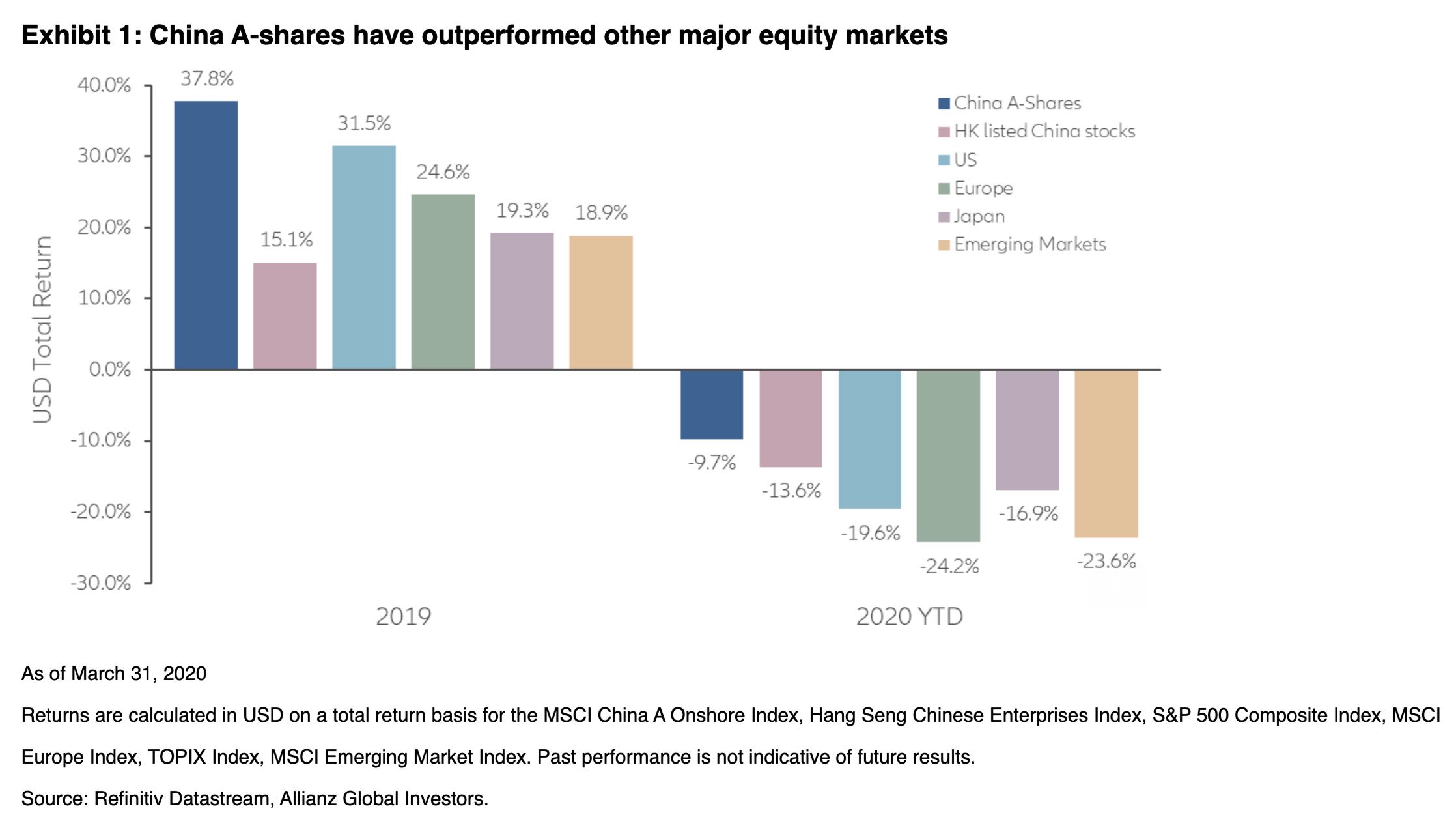China A-Shares: 6 Reasons Why Investors Should Consider Them
It's not just about a Chinese recovery. It's about where that recovery should be most fruitful.

China A-shares – domestic stocks traded in Shenzhen and Shanghai – have performed relatively well during this crisis. That fact might surprise many investors given that Asia's largest economy was home to the COVID-19 coronavirus outbreak that has claimed so many lives and brought the global economy to a virtual halt.
The comparative resilience of China A-shares is borne out in the data. While the MSCI China A Onshore Index, a key benchmark for the asset class, was down through the end of March, A-shares have shown relative strength compared to the S&P 500 and MSCI Europe indices (Exhibit 1). They also have outperformed "offshore" China companies (H-shares, traded in Hong Kong, and American Depositary Receipts traded in the U.S.).

The question now: Can investors expect this outperformance to be sustainable over the long-run and is an allocation to A-shares still a good opportunity today?

Sign up for Kiplinger’s Free E-Newsletters
Profit and prosper with the best of expert advice on investing, taxes, retirement, personal finance and more - straight to your e-mail.
Profit and prosper with the best of expert advice - straight to your e-mail.
Six Reasons Why the Answer Might Be Yes
- China A-shares have historically been uncorrelated to other major equity indices. The correlation of A-shares with world equities was around 0.2 over the past decade, while the correlation with U.S. and European equities was even lower, according to Bloomberg data from the end of January 2020. That means including A-shares in a global portfolio might enhance optimization by generating a potentially better risk-return profile. Crucially, these low correlations have held up during the current crisis.
- China is getting back to work. The coronavirus appears to be contained in China after strict quarantine measures. Most of China's large companies and around two-thirds of its small- to medium-size companies have resumed work, according to China's Ministry of Industry and Information Technology. We held a large number of company calls in late March and were positively surprised about the pace of recovery, with most companies indicating they are operating at more than 75% capacity. This bodes particularly well for the recovery of China's domestic economy and for local consumption.
- China A-shares are largely shielded from global economic woes. As the domestic Chinese economy gets back to full speed, that is especially beneficial for A-share firms. That's because these companies typically generate 90% or more of their revenues domestically and engage in little foreign trade, therefore shielding them from economic weakness elsewhere.
- Chinese economic growth should rebound. Although the country is not yet out of danger, assuming China does not suffer a massive second wave of COVID-19 infection, we expect its economy will recover in the second half of this year. To be sure, it has been a particularly challenging year – before COVID-19, there was the African swine fever, the U.S. trade war and protests in Hong Kong. Nevertheless, currency and bond markets have been remarkably stable and, as noted earlier, Chinese equity markets have outperformed. It seems unlikely that China is facing the same sort of solvency stress as the rest of the world. Additionally, while firms reliant on trade may struggle as U.S. and European demand ebbs, we expect a pick-up in earnings from A-share companies as the domestic economy gets back to work. Also, Beijing has signaled it stands ready to use fiscal stimulus to achieve full-year economic targets.
- Technical factors support China A-shares. Domestic investors in China can typically only purchase bonds, property and A-shares. Low yields on domestic bonds coupled with high property prices support the trend of domestic investors continuing to demand A-shares. Domestic investors, employees and management of A-share firms have increased their ownership in the past two years: a trend we expect will continue. Foreign inflows to China A-shares should also persist as MSCI remains on track on its plan to gradually increase A-share weightings in their indices.
- Monetary policy is supportive. We are also optimistic because The People's Bank of China (PBoC) has higher interest rates than the U.S., Europe and Japan, giving it flexibility to cut rates further if economic growth falters. That said, we expect Chinese rates would remain higher than other regions even in the event of some easing by the central bank. Higher rates – the seven-day reverse repurchase rate is 2.2% after a March 30 cut – bode well for attracting capital inflows.
Among the best-performing sectors during the recent relative outperformance of A-shares have been industrials and capital goods. A-shares also have a heavy weighting toward consumer staples – a sector that is expected to perform well in the current environment.
Another reason to expect A-shares to perform well relative to U.S. equities is that whereas corporate stock buybacks were pervasive in the United States in recent years (and now are being cut back), in 2019, A-share firms only bought back 0.25% of their outstanding shares.
We have consistently contended that investors should diversify their portfolios for the long run with an allocation to A-shares. While many investors are understandably cautious about taking risk amid so much uncertainty, we nevertheless believe that this is a good time to consider A-shares, especially in light of currently discounted prices.
Anthony Wong, CFA is a lead manager responsible for China A-share equity portfolios and Shannon Zheng is a product specialist covering regional and China equity strategies, both for Allianz Global Investors based in Hong Kong.
Get Kiplinger Today newsletter — free
Profit and prosper with the best of Kiplinger's advice on investing, taxes, retirement, personal finance and much more. Delivered daily. Enter your email in the box and click Sign Me Up.
-
 Stock Market Today: Stocks Soar on China Trade Talk Hopes
Stock Market Today: Stocks Soar on China Trade Talk HopesTreasury Secretary Bessent said current U.S.-China trade relations are unsustainable and signaled hopes for negotiations.
By Karee Venema
-
 2026 Disney Dining Plan Returns: Free Dining for Kids & Resort Benefits
2026 Disney Dining Plan Returns: Free Dining for Kids & Resort BenefitsPlan your 2026 Walt Disney World vacation now. Learn about the returning Disney Dining Plan, how kids aged three to nine eat free, and the exclusive benefits of staying at a Disney Resort hotel.
By Carla Ayers
-
 Stock Market Today: Stocks Soar on China Trade Talk Hopes
Stock Market Today: Stocks Soar on China Trade Talk HopesTreasury Secretary Bessent said current U.S.-China trade relations are unsustainable and signaled hopes for negotiations.
By Karee Venema
-
 Stock Market Today: Dow Drops 971 Points as Powell Pressure Ramps Up
Stock Market Today: Dow Drops 971 Points as Powell Pressure Ramps UpPresident Trump is increasing his attacks against Jerome Powell, insisting the Fed chair cut interest rates.
By Karee Venema
-
 Stock Market Today: No 'Powell Put'? No Problem
Stock Market Today: No 'Powell Put'? No ProblemInvestors, traders and speculators look beyond both another Trump post and more signs of slowing economic activity.
By David Dittman
-
 Stock Market Today: Dow Drops 699 Points After Powell Speech
Stock Market Today: Dow Drops 699 Points After Powell SpeechFed Chair Powell warned of a slowing economy and higher inflation but said the central bank isn't ready to cut rates just yet.
By Karee Venema
-
 Stock Market Today: Stocks Struggle Amid Tariff Uncertainty
Stock Market Today: Stocks Struggle Amid Tariff UncertaintyBoeing dropped after China suspended new aircraft orders, while Bank of America and Citi climbed on earnings beats.
By Karee Venema
-
 Stock Market Today: Stocks Gain on Tech, Auto Tariff Talk
Stock Market Today: Stocks Gain on Tech, Auto Tariff TalkThe Trump administration said late Friday that it will temporarily halt tariffs on some Chinese tech imports.
By Karee Venema
-
 Stock Market Today: Stocks Surge to Close a Volatile Week
Stock Market Today: Stocks Surge to Close a Volatile WeekIt was another day with a week's worth of both news and price action, but it ended on a strongly positive note.
By David Dittman
-
 Stock Market Today: Uncertainty Proliferates: Dow Loses 1,014 Points
Stock Market Today: Uncertainty Proliferates: Dow Loses 1,014 PointsWeaker-than-expected consumer inflation data wasn't enough to stabilize sentiment during another volatile day for financial markets.
By David Dittman